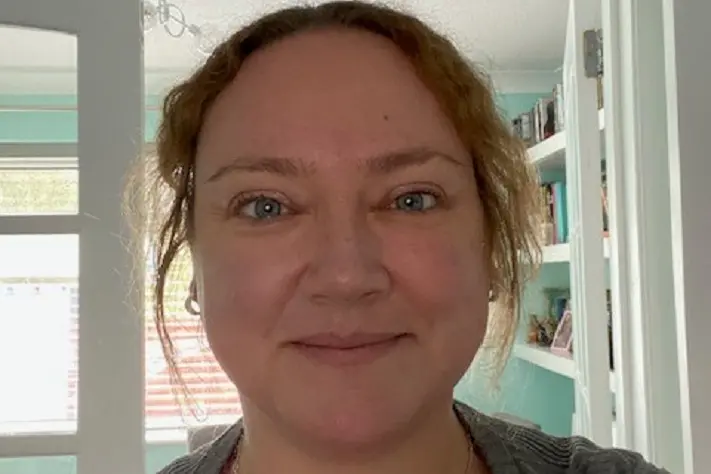20th November 2020
A Voices blog by Natasha James, Clinical Lead for Health Visiting South Bristol, on understanding about the benefits of ‘Tummy Time’. Natasha has an interest in Physical Activity in the under 5s and is currently doing a PhD in this area.

Natasha James – Clinical Lead for Health Visiting South Bristol
The “UK Chief Medical Officers’ Physical Activity Guidelines” (Department of Health and Social Care 2019) recommend that infants that are not yet mobile should have thirty minutes of ‘Tummy Time’ throughout the day, as well as time spent reaching , grasping , rolling and other movement appropriate for their stage of development.
As Health Visitors, we encourage ‘Tummy Time’ but are we aware of all the benefits of ‘Tummy Time’ and how it can have such a positive impact on the future outcomes for children? In particular, the link between ‘Tummy Time’ and communication skills.
The research behind the physical activity guidelines found that, for infants, spending thirty minutes or more in the prone position throughout the day was associated with an increased likelihood of reaching their motor development milestones at an earlier age. Motor skill development was also found to be more favourable in this group (Carson et al.2017).
Infants reach their milestones at different ages, so why do we need to encourage reaching motor milestones at an earlier age?
As well as having many physical benefits (Tremblay et al,2017), research suggests that motor development is also associated with language development (Ora Oudgenoeg-Paz, Volman and Leseman 2012, Wang et al.2012, Bernadis et al.2008). There is now a growing body of evidence linking the changes in social interactions that accompany the onset of crawling and walking, with language development (He, Walle and Campos 2015, Clearfield 2011).
Studies found that crawling infants spent more time in interactive play with their caregivers than infants of the same age that were not yet crawling (Clearfield 2011). He, Walle and Campos (2015) found that, in a group of infants the same age, the walking infants had more positive receptive and productive vocabularies than the infants who were still crawling. The study found that the walking infants participated in more object exploration, more sharing with caregivers, more gesturing, and more attempts to gain attention. These actions led to an increase in caregiver response and interaction in the walking infant group (He, Walle and Campos 2015).
It is not the ability to walk that causes the change in communication but the new experience and interaction with the environment that creates a richer, socially interactive learning context in which language can develop (Clearfield 2011). Therefore, by promoting ‘Tummy Time’ in relation to motor development, we are empowering caregivers to create richer learning environments for their child at an earlier age. This will contribute to supporting future outcomes such as ‘readiness for school’ as well as benefits to general physical health through increased physical activity (Department of Health and Social Care 2019, Wintersgill 2019).
In my role, I raise awareness of the importance of informing parents about the benefits of physical activity for their child. The ‘UK Chief Medical Officers’ Guide to Physical Activity’ (Department of Health and Social Care 2019) includes infographics that can be downloaded and used with parents which includes ‘Tummy Time’. I have included a link to this below:
I hope this has been informative and increased your understanding about the benefits of ‘Tummy Time’.
Natasha James – Clinical Lead for Health Visiting South Bristol
References:
Bernadis, P. Bello, A. Pettanati, P. Stefanini, S. Gentilucci, M. (2008) Manual actions affect vocalisations of infants. Exp Brain Res. 184 pp599-603.
Carson, V. Lee, EY. Hewitt, L. Jennings, C. Hunter, S. Kuzik, N. Stearns, J. Powley Unrau, S. Poitras, V. Gray, C. Adame, K. Janssen, I. Okely, A. Spence, J. Timmons, B. Sampson, M. Tremblay, M. (2017) Systematic review of the relationships between physical activity and health indicators in the early years (0-4 years). BMC Public Health. 17(suppl5): 854.
Clearfield, M. (2011) Learning to walk changes infants’ social interactions. Infant Behaviour and Development. 34 pp 15-25.
Department of Health and Social Care. (2019) Uk Chief Medical Officers’ Physical Activity Guidelines. London: Department of Health and Social Care.
He, M. Walle, E. Campos, J. (2015) A Cross-National Investigation of the Relationship Between Infant Walking and Language Development. Journal of the International Society of Infant Studies. 20(3) pp 283-305.
Ora Oudgenoeg-Paz, M. Volman, J. Leseman, P. (2012) Infants Behaviour and Development. 35 pp733-736.
Tremblay, M. Caput, J. Adamo, K. Aubert, S. Barnes, J. Choquette, L. Duggan, M. Faulkner, G. Goldfield, C. Gray, C. Gruber, R. Janson, K. Janssen, I. Janssen, X. Garcia, A. Kuzik, N. LaBlanc, C. Maclean, J. Okely, A. Poitras, V. Rayner, M. Reilly, J. Sampson, M. Spence, J. Timmons, B. Carson, V. (2017) Canadian 24-Hour Movement Guidelines for the Early Years (0-4 years): An Integration of Physical Activity, Sedentary Behaviour and Sleep. BMC Public Health. 17(Suppl5): 874.
Wang, M. Lekhal, R. Aaro, L. Schjolberg, S. (2012) Co-occuring development of early childhood communication and motor skills: results from a population-based longitudinal study. Child: care, health and development. 40 (1) pp77-84.
Wintersgill, G. (2019) Unfit for Life? Physical inactivity among the UK’s children is at crisis point. What can be done? Community Practitioner. 92(3) pp34-39.

